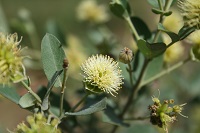Carotenoids content and antibacterial activity from galls of guiera senegalensis j.f. Gmel (combretaceae).
Keywords:
Guiera senegalensis, Galls, Antibacterial activity, carotenoid contentAbstract
Guiera senegalensis is a well known medicinal plant which is used as a drug in Burkina Faso. The purpose of the present study was to investigate the carotenoids content and antibacterial activity from galls of Guiera senegalensis. The hydroacetonic extract (HAE) exhibited the highest of β-carotene (4.67±0.25 mg/g) and lycopene (0.99±0.0735 mg/g) content. The extracts and fractions of galls exhibited antimicrobial activity against some gram positive and gram negative bacteria. We observed an inhibitory activity of the extracts against Bacillus cereus ATCC 13061 and Staphylococus aureus ATCC 6538 which showed a resistance to the penicillin and ampicillin. The ratio of the MBC and the MIC showed that the hydroacetonic extract is bactericidal against all the bacterial strains used except for Proteus mirabilis ATCC 35659. The aqueous decoction extract is bactericidal against all the bacterial species tested. The present study thus suggested that galls from G senegalensis may be used as a new potential source of natural nutraceutical components.
References
. Verghese M, Richardson J E,
Boateng J, Schackelford L A,
Howard C, Walker L T Chawan C B.
Dietary lycopene has a protective
effect on cardiovascular disease in
new Zealand male rabbits. J.Biol.
Sci 2008, 8: 268-277.
. Mohamed MS, El Mougi M T,
Mansour E H, and Saad H H.
Administration of lycopene and betacarotene decreased risks of
pneumonia among children.
Pakistan Journal of Nutrition 2008,
: 273-277.
. Rosati C, Aquilani R, Dharmapuri S,
Pallara P, Marusic C, Tavazza R,
Bouvier F, Camara B, Giuliano G.
Metabolic engineering of betacarotene and lycopene content in
tomato fruit. The plant Journal 2000,
(3), 413-419.
. Kong K W, Ismail A. Lycopene
content and lipophilic antioxidant
capacity of by-products from
Psidium guajava fruits produced
during puree production industry.
Food and bioproducts processing
, in press.
. Alshatwi A A, Obaaid M A A, Sedairy
S A A, Al-Assaf A H, Zhang J J, Lei
K Y. Tomato powder is more
protective than lycopene
supplement against lipid
peroxidation in rats. Nutrition
Research 2010, 30: 66– 73.
. Nacoulma, O.G. (1996). Medicinales
plants and medical practices in
Burkina:case of central plateaul
T1&T2. Doctorat thesis ès Sciences
Nat. Ouagadougou University 1996,
et 285.
. Nagata M, Yamashita, I. Simple
method for simultaneous
determination of chlorophyll and
carotenoids in tomato fruit. Nippon
Shokuhin Kogyo Gakkaish 1992,
(10): 925–928.
. National Committee for Clinical
Laboratory Standards. Methods for
dilution antimicrobial susceptibility
tests for bacteria that grow
aerobically, 5th ed. Vol. 17.
Approved standards-M7-A4. NCCLS
document M7-A4. National
Committee for Clinical Laboratory
Standard Wayen Pa. 2000.
. [Ojala T, Remes S, Haansuu P,
Vuorela H, Hiltunen R, Haahtela K,
Vuorela, P. Antimicrobial activity of
some coumarin containing herbal
plants growing in Finland. Journal of
Ethnopharmacology 2000, 73, 299–
. Berche P, Gaillard J L, Simonet
M.Bacteriology, The bacterial
infection of human. Ed Flammarion
Médecine-Sciences 1988, Paris,
p
. Bestwick C S and Milne L. Effects of
β-carotene on antioxidant enzyme
activity, intracellular reactive oxygen
and membrane integrity within post
confluent Caco-2 intestinal cells.
Biochimica et Biophysica Acta 1999,
: 47-55.
. Choudhary K, Singh M, Pillai U,
Shekhawat N S. Antibacterial
Screening and Phytochemical
investigation of bark extracts of
Acacia jacquemontii Benth. S.J.
Pharm. Sci.2009, 2(2) : 21-26.
. Barros L, Baptista P, Ferreira I C F
R. . Effect of Lactarius piperatus
fruiting body maturity stage on
antioxidant activity measured by
several biochemical assays. Food
and Chemical Toxicology 2007, 45,
–1737
. Yaltirak T, Aslim B, Ozturk S, Alli H.
Antimicrobial and antioxidant
activities of Russula delica Fr. Food
and Chemical Toxicology 2009, 47:
–2056.
. Schlegelova J, Brychta J, Klimova
E, Napravnikova E, Babak V. The
prevalence of and resistance to
antimicrobial agents of Bacillus
cereus isolates from foodstuffs. Vet.
Med. – Czech 2003, 48 (11): 331–
. Cerdeiras MP, Fernández J, Soubes
M, Vero S, Ferreira F, Moyna P,
Olano I, Vázquez A. A new
antibacterial compound from Ibicella
lutea. Journal of
Ethnopharmacology 2000, 73: 521-
. Lamien CE, Meda A, Mans J,
Romito M, Nacoulma O G, Viljoen,
G J. Inhibition of fowlpox virus by an
aqueous acetone extract from galls
of Guiera senegalensis J.F.Gmel
(combretaceae). Journal of
Ethnopharmacology 2005, 96: 249-
. Martini SD, Addario C, Colacevich
A, Focardi S, Borghini F, Santucci A,
Figura N, Rossi C. Antimicrobial
activity against Helicobacter pylori
strains and antioxidant properties of
blackberry leaves (Rubus ulmifolius)
and isolated compounds.
International Journal of Antimicrobial
Agents 2009, 34 : 50–59.
. Cushnie, T P T, Lamb A J. Review
Antimicrobial activity of flavonoids.
International Journal of Antimicrobial
Agents 2005, 26: 343–356.
. Formica J V and Wregelsont W.
Review of the Biology of Quercetin
and Related Bioflavonoids. Fd
Chem. Toxic 1995, 33: 1061-1080.
. Sombié, P A E D, Hilou A, Mounier
C, Coulibaly A Y, Kiendrebeogo M,
Millogo F J, Nacoulma O G.
Antioxidant and anti-inflammatory
activities from galls of Guiera
senegalensis J.F. GMEL
(Combretaceae). Research Journal
of Medicinal Plant.2011, 1819-3455.
. Nostro A, Germano M P, D’Angelo
V, Marino A, Cannatelli M A.
Extraction methods and
bioautography for evaluation of
medicinal plant antimicrobial activity,
Letters in Applied Microbiology,
, 30, 379-348.
. Arias M E, Gomez J D, Cudmani, N
M, Vattuone M A, Isla M I.
Antibacterial activity of ethanolic and
aqueous extracts of Acacia aroma
Gill. ex Hook et Arn. Life Sciences
, 75, 191–202.
. Hou L, Shi Y, Zhai P, Le G .
Antibacterial activity and in vitro antitumor activity of the extract of the
larvae of the housefly (Musca
domestica). Journal of
Ethnopharmacology 2007, 111:
–231.



